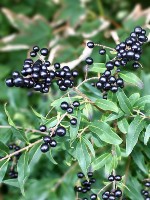Mon-Fri 9am - 5pm Mountain time
Garrington Chokecherry vs Wild Privet
Ligustrum vulgare
Prunus virginiana Garrington
NOT AVAILABLE THIS SEASON - MIGHT RETURN
NOT AVAILABLE THIS SEASON - MIGHT RETURN
Wild Privet is a fast growing ornamental shrub that is well suited for forming hedges and privacy screens. It will retain its leaves in warmer climates but drops them in colder areas. They have small white flowers, though the smell is often considered unpleasant. While the berries are inedible, they are a good food source for many bird species.
It is recommended to prune Wild Privet immediately after flowering, as it can readily self seed. It is deer and rabbit tolerant. It can grow in dry areas, on slopes, and withstand the wind making it well suited for many growing conditions.
Garrington Chokecherry is a self-fertile and rare chokecherry that is commonly used for commercial orchards. This highly prized selection is known for its heavy yields of large, reddish-black fruit that are easily harvested with an over row harvester.
Garrington Chokecherry is also commonly used for hedges and edible landscaping. This shrubs' chokecherries are commonly used in baking, preserves, wine, and jams or jellies.
Wild Privet Quick Facts
Garrington Chokecherry Quick Facts
Toxicity: If ingested, all parts of this plant will cause severe discomfort. Toxic to dogs, cats, and horses

